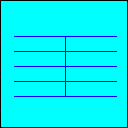 Bar lines are placed on the musical staff to
separate the divisions of time. Time is divided in groups of pulses as defined in the time
signature. The space between two bar line is called a measure or bar.
Bar lines are placed on the musical staff to
separate the divisions of time. Time is divided in groups of pulses as defined in the time
signature. The space between two bar line is called a measure or bar.
![]()
There are different types of bar lines that indicate a particular way to perform in time. There are also repeat bars with accompanying markings and symbols that indicate which passage is to be repeated.
 The single line has no purpose other than to divide
the musical staff into measures. The
double line is usually used when a major change occurs in the music, such as a key change or metre change. Often, double
lines are used to divide one complete musical idea from another. This enables performers
to easily recognize the beginning or end of a major musical section.
The single line has no purpose other than to divide
the musical staff into measures. The
double line is usually used when a major change occurs in the music, such as a key change or metre change. Often, double
lines are used to divide one complete musical idea from another. This enables performers
to easily recognize the beginning or end of a major musical section.
 A double bar line, not to be confused with the
double line, indicates that the end of the piece has been reached.
A double bar line, not to be confused with the
double line, indicates that the end of the piece has been reached.
 The dashed bar line indicates that time within a measure is approximate. It may also indicate a subdivision of time
due to complex rhythms.
The dashed bar line indicates that time within a measure is approximate. It may also indicate a subdivision of time
due to complex rhythms.
 The absence of bar lines indicates that time is unmeasured. The music usually
moves freely in time without a steady pulse or beat. Rhythmic
values are continually held for their proper duration as the tempo
varies slightly.
The absence of bar lines indicates that time is unmeasured. The music usually
moves freely in time without a steady pulse or beat. Rhythmic
values are continually held for their proper duration as the tempo
varies slightly.
 Repeat bars, that have a pair of dots on the left of
the double bar, indicate that the music is to be repeated from a double bar having a pair
of dots to its right. If there are no double bars, with a pair of dots on its right, the
music is repeated from the beginning.
Repeat bars, that have a pair of dots on the left of
the double bar, indicate that the music is to be repeated from a double bar having a pair
of dots to its right. If there are no double bars, with a pair of dots on its right, the
music is repeated from the beginning.
 Repeat endings may have bracketed numbers indicating
the order in which such endings are to be played. After playing through the first time,
the performer takes the first ending for the repeat. The second time the performer will
take the second ending and so on.
Repeat endings may have bracketed numbers indicating
the order in which such endings are to be played. After playing through the first time,
the performer takes the first ending for the repeat. The second time the performer will
take the second ending and so on.